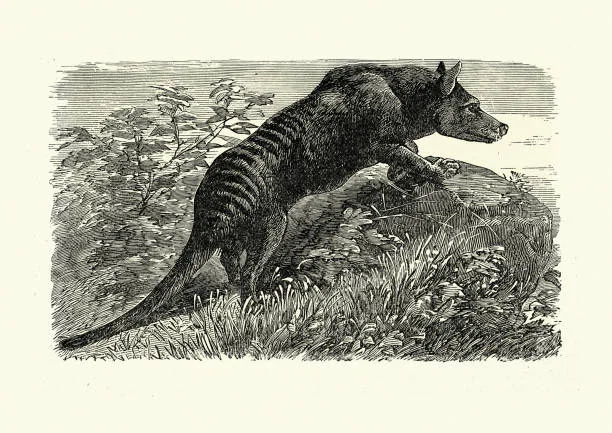Sometimes species become extinct for natural reasons; this is normal and natural. Recently, the animal world has been actively thinning out thanks to us and our activities, which is already bad. Often, the intervention is direct, such as poaching for large trophies or animal tusks, and sometimes it is indirect, for example, when reclaimed land violates habitats and entire ecosystems. We have picked up 10 entirely disappeared animals that recently lived among us, but now they are history.
Thylacine

The carnivore also called the Tasmanian tiger and the Tasmanian wolf, was a marsupial that hunted rodents and kangaroos primarily at night. Although the thylacine looked very harsh, they were rather timid and susceptible animals, for which they paid – they were easy prey for hunters.
In 1999, scientists tried to clone thylacine using DNA from puppies of this animal, which are preserved in the museum. The attempt failed.
Quagga
This subspecies of Burchell’s zebra, which lived on the territory of what is now South Africa, became extinct at the end of the 19th century. The quagga was widespread in a relatively limited area but gradually began to die out due to uncontrolled hunting, its small range, and competition for food, oddly enough, with livestock.
The last wild quagga died in 1878, and the last quagga in the world kept in the Amsterdam Zoo died on August 13, 1883. After that, this zebra was not considered extinct for a long time and was recognized as such at the international level only in 1900.
Northern white rhino
Since March 19, 2018, only two females of this subspecies remain, making the northern white rhino functionally extinct. Both females belong to the Dvur Kralove Zoo in the Czech Republic but live in the Ol Padjeta Nature Reserve in Kenya and are guarded around the clock by armed rangers.
The last male who lived there died of old age at the age of 45. True, this story has a good ending. In the summer of 2019, one of the females gave birth to a healthy northern white rhino calf using IVF.
Blue macaw
The last male that lived in the wild disappeared in 2000, and the species is no longer found in the wild. True, there are still several dozen live birds in private collections and zoos. Man, of course, is the leading cause of extinction, but not the only one.
Africanized bees, nicknamed “killer bees,” occupied all the hollows suitable for nesting in this area and evicted the blue macaws from their favorite habitats.
Passenger pigeon
By some estimates, the number of wandering pigeons numbered in the millions and even billions when the first Europeans began to settle in America. The wandering pigeon was an important food source for the indigenous people of North America, but they hunted pigeons humanely and reasonably.
After colonization, hunting became more intensive and sophisticated. Wandering pigeons were killed so easily that they were not even considered game birds. The last known bird died in captivity at the Cincinnati Zoo in 1914.
Golden toad
A small but damn bright toad that lived in a limited area of the rainforest of Costa Rica. It was first described in 1966, but after 1989 no one saw it. After several unsuccessful attempts to locate extinct toads in the 1990s, scientists began to debate the possible reasons for their extinction.
Chytridiomycosis, a deadly skin disease, is believed to have wiped out this population of toads, which were already vulnerable due to their limited habitat.
Zanzibar leopard
Endemic to the Unguja island of the Zanzibar archipelago, which is part of Tanzania. In the 20th century, the conflict between residents and leopards on the island escalated, as a result, the image of leopards was demonized, and extermination began to be purposeful.
The last meeting of the scientist with the Zanzibar leopard took place in the early 1980s. Since then, there has not been a single case of reliable observation of it.
West African black rhino
This subspecies of the black rhinoceros has been officially declared extinct since November 10, 2013. Like all other rhinos, it fell victim to the ridiculous, unfounded superstition about the miraculous power of the horn.
In the 70s, during a period of rapid growth in the prosperity of the oil monarchies of the Persian Gulf, many black rhinos were mined for the sake of the fashion that appeared in these countries for daggers with horns that were considered an indispensable attribute of a wealthy Arab. Nowadays, rhino horn is in constant demand in Chinese medicine, while, according to scientific data, it does not have any healing properties.
Javan tiger
Javan tigers lived on the Indonesian island of Java. Presumably died out in the 80s of the XX century due to hunting and destruction of the habitat. The first preconditions for the subspecies’ extinction had arisen since the 1950s when the number of tigers in Java decreased to 25 individuals.
By 1972, the number of Javan tigers had dwindled to seven individuals living in the Meru Betiri Forest Reserve, and perhaps five more individuals lived in other reserves. In 1979, only three individuals remained. The exact time of the extinction of the subspecies remains unknown; it probably happened in the mid-1980s.
Abingdon Island tortoise
When Darwin visited the Galapagos Islands in 1835, it was full of these huge turtles. But very quickly, their numbers dwindled to Lonesome George – the last purebred representative of the Abingdon island turtle.
But on June 24, 2012, the body of a unique reptile was discovered without signs of life by the reserve keeper Fausto Llerena, who has been caring for the turtle for the past 40 years. Lonesome George died at the age of about 100 years without giving birth to offspring.
